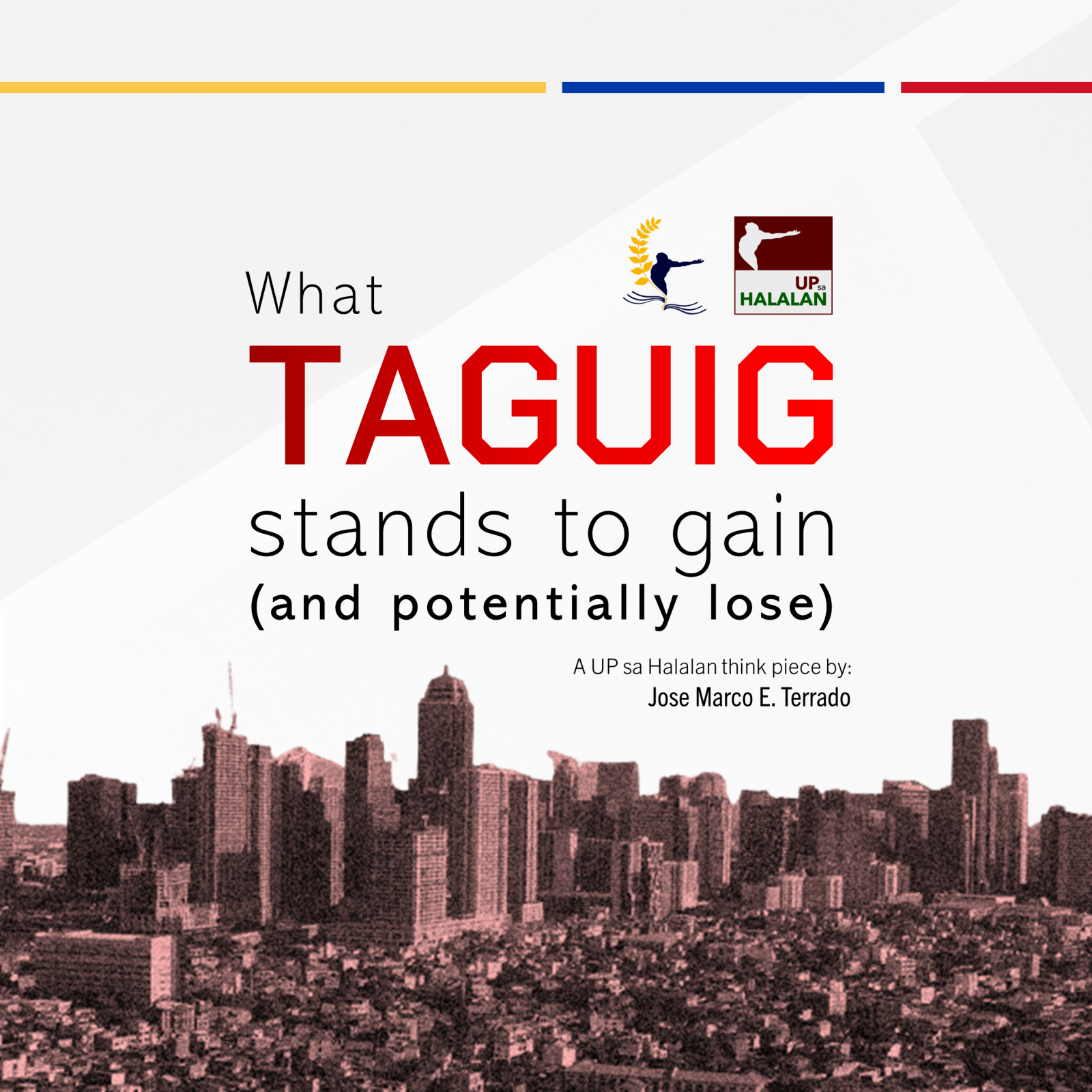Taguig did not win their claim free from risk. It can be argued that Taguig might be receiving a political trojan horse that is waiting for an opportunity to strike.

In our previous article, we talked about how things in Makati are about to get complicated due to the political and social implications of the Supreme Court’s decision upholding Taguig’s claim over the 10 barangays covering the EMBOs and Fort Bonifacio.
This time, we shall focus on Taguig City and what it stands to gain (and potentially lose) from this Supreme Court decision.
Jackpot for Taguig?

On its face, Taguig may seem to have hit the jackpot by gaining control over these barangays. Having more citizens and land area actually means millions of pesos in terms of local governance. For example, in Section 285 of the Local Government Code, 75% of the formula to compute the share of a city in the Internal Revenue Allotment (now expanded to the National Tax Allocation as a result of the the Mandanas-Garcia Supreme Court ruling) is the population and land area of the city. This means that Taguig City could be able to claim a larger share of national taxes with the additional square meters and 326,000 residents of these barangays.
Taguig will also get a lot richer with the revenues earned by these barangays. All residents of these barangays would now have to pay real property taxes in Taguig, which are higher than Makati. Business permits and other regulatory fines and local taxes shall now be paid to Taguig.
Politically, Taguig now has the case to argue for an additional congressional district. Currently, it has two districts – the 1st District of Taguig-Pateros and the 2nd District of Taguig. In the event that a third district is carved out for Taguig, not only would they have one more representative in Congress but also eight more councilors in their Sangguniang Panlungsod.
The creation of a new Taguig district (and the abolition of the existing Makati district) is a constitutional power vested in Congress alone. Hence, there is a standing legal opinion raised by a congressman that it would take a law to fix this anomalous and confusing state of the 2nd District of Makati. For now, the 2nd District of Makati is here to stay as an odd mix of Makati and Taguig barangays.
Nevertheless, the potential political gains for Taguig in terms of representation are theirs for the taking.
A Political Trojan Horse?

Taguig did not win their claim free from risk. It can be argued that Taguig might be receiving a political trojan horse that is waiting for an opportunity to strike.
In our previous article, we stated that the 2nd District is a Binay bailiwick. A Binay has represented this district for nine consecutive terms and the district has always strongly delivered for the Binays in their mayoral bids. Hence, it would be difficult to undo the political influence that the Binays hold over this area. The coming months or years would be a test of loyalty for the decades worth of social and political accommodations which the Binays have given to this district.
With the Supreme Court decision, Taguig has the full legal authority to exercise jurisdiction over the 10 barangays. However, authority can only go as far as the corners of the 53 pages of that decision. Despite the full backing of the law, we all know that one still has to win the hearts and minds of the citizens to fully exercise influence. With the shadow of the Binays looming over this area, Taguig might have a difficult time trying to do just that.
We cannot resist engaging with an interesting hypothetical scenario of the Binays expanding their political space to Taguig.
Some have even suggested that Mayor Abby Binay herself could run for Mayor of Taguig, but before we get ahead of ourselves, Mayor Binay cannot simply change her residence to Taguig without resigning her current position as Mayor of Makati, since an incumbent mayor of another city cannot be a resident of another city one year prior to the next election. This makes the whole idea highly unlikely.
However, this does not mean that the Binays cannot involve themselves in Taguig politics. These barangays are unfamiliar electoral terrain for Taguig’s political elite. Hence, the area can now be a political weapon of sorts – a trojan horse – that the Binays may use to influence the outcome of the next Taguig City elections.
One way they might do this depends on the fate of the current 2nd District of Makati. If Congress will not change the composition of this district by 2025, then the term-limited Mayor Abby Binay could return to her former seat in Congress and continue to exert some political power over the EMBOs and Fort Bonifacio. Her candidacy would be a walk in the park, and would necessarily draw her into the mix of Taguig politics for technically becoming the city’s third district representative.
If Congress would reapportion the district, severing the 10 Taguig barangays’ ties with the remaining 3 barangays in Makati, then we can effectively disqualify Mayor Abby herself or her husband from the race. However, this does not rule out the possibility of a Binay-backed, pro-Makati candidate in the new Taguig district running in the area. The electoral viability of this hypothetical candidate depends on the composition of the new Taguig district – whether these 10 barangays would be enough to comprise an electoral majority of the district.
Another implication of a future reapportionment is that Taguig’s new district would open up eight additional seats in their Sangguniang Panlungsod. As mentioned in the previous article, at least four councilors of Makati are from the EMBOs and could run, this time, in the Taguig Sanggunian. If this district is drawn in a way where ex-Makati residents would make a majority of voters, then it would not be a surprise to see eight Binay-backed councilors in the Taguig City Council.
But what about the mayoral race? If we would test the viability of a Binay-backed candidate for Mayor in Taguig, we can look at the 2022 elections. Based on COMELEC’s turnout data, 203,822 voters turned out from the 2nd District of Makati. 164,948 of these voters voted for Luis Campos. Meanwhile, 371,575 voters turned out in Taguig. Based on Taguig’s local election results, 271,422 voted for Mayor Lani Cayetano, while 87,164 voted for her opponent.
If we add those who voted against Cayetano in Taguig and those who voted for Campos in Makati, their electoral base would total around 251,000 votes, which is 20,000 votes shy of the Cayetano base.
The path for a Binay-backed Mayor of Taguig does not seem so clear if they desire to branch out of the 10 barangays. However, the political landscape has definitely changed in both Makati and Taguig. These EMBO residents may be more politically energized now, more than ever. Furthermore, the prospect of a strong alternative against the Cayetanos in Taguig has not been tested yet. The last time the Cayetanos were seriously challenged in the city was when they were the challengers for the mayorship in 2010, where Mayor Lani Cayetano won by only 2,420 votes against the former ruling dynasty of Taguig. Whether Taguig is ready for an alternative offered by their next-door neighbors is not something that we are ready to rule out for now.
All of these could only be possible if the Binays could maintain their influence over the 10 barangays. This is why the next 2 years will be a test of loyalty. These residents can no longer receive most of their previous benefits from Makati, except those, perhaps, from their District Office, since Rep. Campos remains to be their congressman. It would be interesting to see how loyalties can be maintained when the city now lacks the power to give to its former residents.
The First Shots Have Been Fired

Nevertheless, the Binays have already dipped their fingers into Taguig politics by criticizing Taguig’s current leadership. It may be a sign of what is to come.
Mayor Abby Binay has already begun firing tirades against the Taguig City government in an emotional video of hers released last July 17. There, she questioned Taguig’s capacity to match Makati’s treatment of its residents by asking a rhetorical question: Hindi ba dapat lang na maging bahagi ang mga taga-Taguig sa pagyaman ng Taguig?
Her Twitter account has also framed Taguig as credit-grabbers of the University of Makati and the Ospital ng Makati by saying pati ba naman ito, gusto nilang kamkamin?
These can be potential narratives for what would become a bitter rivalry between Makati and Taguig, which is also a battle between their respective ruling dynasties: the Binays and the Cayetanos.
On the one hand, this competition can be good. The residents of these barangays now have two cities courting their approval, and they may be caught between the best of both worlds of the two cities’ social welfare systems.
On the other hand, with political tensions at their peak, there runs a risk of factionalism, the politicization of public funds and accommodations, and worst of all, violence – all because of the competing political interests of two families.
The upcoming Barangay and Sangguniang Kabataan Elections this October could be a preview of what is to come. It would be interesting to note the political views and positions of the candidates of these barangays on being part of Taguig and how voters would respond to these messages. Despite the matter of which city they should belong to not being on the ballot, it would possibly be a thought that would linger in the minds of voters as they cast their ballots.
Marco Terrado is a BA Political Science graduate from UP Diliman last 2022 and is currently enrolled in the Juris Doctor program of the UP College of Law. He is also a part-time communications consultant in the House of Representatives.
